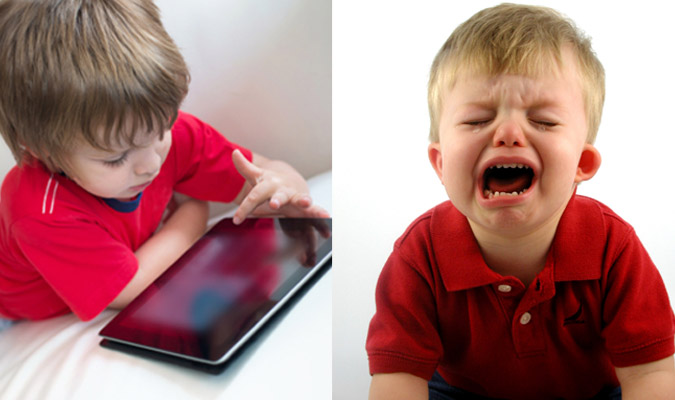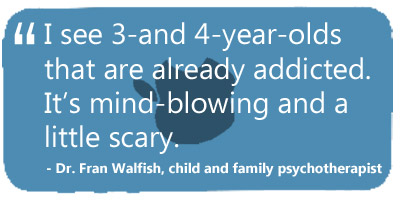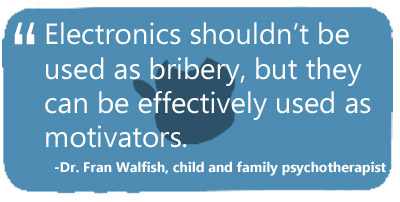My daughter had taught herself to swipe open an iPhone before she could walk, and since then, has a go-to slate of apps she navigates to, fiddles with and, occasionally, deletes (along with emails, it turns out). She is not yet 2 years old. Despite our best efforts, she is drawn to the glow of a smartphone or tablet like the proverbial moth to flame, and it is when we try to wrest it from her tiny mitts that we have discovered the modern phenomenon of the tech tantrum.
Go anywhere today and kids are alternately staring with zombielike glazed eyes at a tablet, or having meltdowns when they're snatched away — in restaurants, at the mall, on buses and subway, and naturally, on planes. If this all were in a movie, we're at the point in the plot where suddenly our hero realizes that there's something not right.
And he's got a baaad feeling about it.
MORE: Best Tablets Apps for Kids
A few numbers to put this blossoming trend in context. A Nielsen report last year found that in tablet-owning households, 7 out of 10 parents let their kids play with their tablets. And a recent Pew study found that tablets are in 30 percent of U.S. households already, and that smartphones were used by 61 percent of mobile subscribers. Taken together, most of the 110 million households in the United States likely have at least one smartphone, and a few tens of millions of households have tablets (and some 40 percent of them are iPads).
Dr. Fran Walfish, a Los Angeles-based child and family psychotherapist and author of "The Self-Aware Parent" (Palgrave Macmillan, 2010), said that she regularly deals with issues of toddlers, tech and tantrums in her practice. "We have a lot of 2-year-olds using tablets now, and I see 3- and 4-year-olds that are already addicted," she said. "It's mind-blowing and a little scary."
Dr. Gary Small, professor of psychiatry and director of the UCLA Longevity Center at the Semel Institute for Neuroscience & Human Behavior, suggests that it's likely these devices are uniquely addictive to kids by their very nature. "One of the wonderful things with this technology is that there's always something new you can do — it's almost infinite. For that very reason, it's very difficult to give up and stop using them."
Sign up to receive The Snapshot, a free special dispatch from Laptop Mag, in your inbox.
Here are a few tips and tools for lessening tech tantrum flareups.
1. Limit exposure time
Though the American Academy of Pediatrics has yet to adopt an official stance when it comes to using these devices, Walfish extends their recommendation that kids under the age of 2 not watch any TV to include tablets and smartphones. For preschool age kids, she said parents should limit kids' screen time to about 30 minutes total per day, bumping that up to 45 minutes for kindergartners, and added that kids shouldn't be left alone to play with the devices.
There are several timer-style apps that shut down a device after set periods of use, such as Kid Time ($2.99; iOS), Kaboom (99 cents; iOS) and Kido’Z Play Mode (Free; Android). Note that older kids will figure out how to bypass these apps, so you'll need to enable passwords to unlock your devices. Devices like the Amazon Kindle Fire HD offer features such as FreeTime, which allows you to set a time limit on tablet use.
MORE: 10 Terrible Tech Frustrations My Toddler Will Never Have
2. Control what content they use
Kids should be restricted to games and apps you've vetted ahead of time. "For preschool kids, it should only be educational apps to help learn numbers, letters, colors and so on — ones which mimic the skills they're learning," Walfish said.
With iOS devices you can restrict and password protect the use of specific apps and types of content in the Settings menu, including the ability to add, buy or delete apps, or access movies or music, or access only kid-rated content among others. For Android, you can set up multiple user accounts so that your child has his own account, and only accesses apps you install. Tablets such as the child-focused Fuhu Nabi 2 come with powerful parental controls, including time-limit settings and app access restrictions.
MORE: Mobile App Ratings Help You Protect Your Kids
3. Restrict access to stores
With the ability to make in-app purchases, your kid can quickly run up ludicrously high charges on your credit card (in one case, about $2,500 in a few minutes) without even needing a password. Lock down access to app and media stores so that your kid can't download anything without using a password.
For iOS, you can turn on restrictions in Settings and turn off in-app purchases altogether. Similarly for Android, you can require a password for all downloads, which includes in-app purchases.
4. Use devices as motivators — not bribes
"Electronics shouldn't be used as bribery, but they can be effectively used as motivators," Walfish said. "Parents can say 'show me you can get in the car seat and buckle your seatbelt and I can let you play on the iPad today when we get home.'" That's a world different than offering access for not acting poorly. Walfish also pointed out that also doesn't mean dangling your iPad like a carrot for every little behavior. It should have a role roughly on a par with ice cream.
Parents can also offer allowance in the form of monthly iTunes credits, and apps like Screen Time ($1.99; iOS) gamifies good behavior so that kids earn access time (for TV, or video games or iPad time) for accomplishing goals.
MORE: Digital Allowance Apps for Parents and Kids
5. Embrace the tantrum
As Walfish points out, tantrums themselves are not only unavoidable, but perfectly normal. However, she cautioned that since they're a form of rebellion, pushing back or scolding your child is precisely the wrong way to go. Walfish counsels parents to embrace the tantrum, and in the moment, be on your kid's side so that the anger becomes the mutual enemy. "Talk it out while it's happening. Say aloud, for example, 'Honey, I know you wanted more game time, it's hard to stop when you want more,’" she said, emphasizing that your voice has to be dripping with empathy and compassion. Doing so drains the engine of your child's anger instead of escalating it into high gear.
6. Lead by example
Most importantly, Walfish points out that kids learn important social cues from their parents. So you can't expect to check your phone 150 times a day (busted!) while eating dinner, playing in the park, watching TV and every moment in between, and not expect your kid to want to do the same. "If you do, your kids will throw your own behavior in your face," Walfish said. "You can't expect kids to behave better than you do."
Bottom line
One of the key tools children need to learn as they grow is the ability to delay gratification, and as these devices are essentially instant gratification in a can, it's up to parents to control access in a responsible and consistent way. "I think this where most parents fall down, which is a nice way of saying 'fail to do their full job,'" Walfish said. "So now, we see toddlers emerge into young childhood and adolescence with not very well practiced and mastered frustration tolerance. Those are the kids that are going to kick and scream and toss their tablet, scream profanities and have meltdowns."





